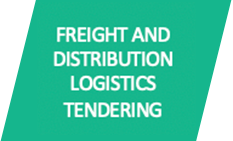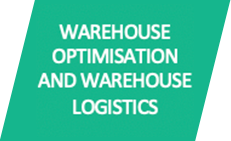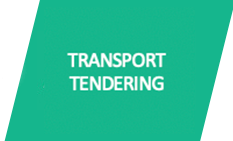Expertise Logistics & Supply Chain Consulting
Reducing costs, optimising working capital, and increasing customer satisfaction are the goals we want to achieve with our clients.
Globalisation, digitalisation, and increasing scarcity of resources in logistics and supply chain management present companies with ever-increasing challenges. Combined with the widening and growing complexity of customer requirements, such challenges demand that companies exhibit agility, reliability, and adaptability. To be cost-effective, efficient, and flexible, supply chains must be strategically aligned, timely, transparent, and controllable. Particular focus is placed on the effective management of supply chain partners, who must be smoothly integrated and sufficiently incentivised to meet the same requirements.
In order to achieve this, we work with our clients across all levels of the supply chain in supply chain consulting and logistics optimisation.
Starting with the design of the supply chain strategy and network, through the implementation of tenders and route and warehouse optimisation, to digitalisation and process optimisation, we support our clients in generating the greatest possible added value and competitive advantages in their supply chain.
Here, we provide insight into typical client challenges, topical questions, and our philosophy within logistics optimisation and modern supply chain consulting.
House of Supply Chain & Logistics
Objectives and added value:
- Development and formulation of a supply chain strategy aligned with the company's objectives
- Development of targets and an evaluation system to control and evaluate the performance of the supply chain
- Answering fundamental supply chain questions
Are we pursuing a suitable supply chain strategy? What is the appropriate level of vertical integration? Where are the production and warehouse locations? How should the network be designed and which transport partners should be involved?
A successful supply chain strategy allows competitive advantages to be continuously assessed and realised and the supply chain to be optimised in a targeted manner. The optimal supply chain makes a decisive contribution to the success of a company by ensuring economic efficiency and customer satisfaction, from the creation of products and services to their delivery. Against the background of the current indsutry conditions, the market, and product development, as well as the procurement and sales markets, we answer the most relevant questions concerning the supply chain strategy and provide some useful tips for implementation.
Objectives and added value:
- Flexibility and adaptability of the supply chain network design to customer needs and market conditions
- Cost-benefit value-added analysis & optimisation of the individual components of the network service offering
- Transparency and meaningful analyses as a basis for decision-making and action across the supply chain network
How do you proceed with supply chain network design? Why do optimisations sometimes fail? What role does digitalisation play?
Supply chain network design is one of the most exciting and complex fields of supply chain management because of the possibilities offered by location selection and transport routes and modes; the potential integration with production, customers and suppliers; and the many new advantages of digitalisation.
The often historically grown networks have to be constantly re-adjusted due to changes in goods and resource availability, customer requirements, and desired service levels, as well as transport and storage costs.
A cost-effective network that meets the ever-growing customer needs is becoming more and more decisive for the success of a company. The German automotive industry, Amazon, Zalando, and others are showing the way - supply chain network design can determine the difference between success and failure.
Objectives and added value:
- Individually optimised target system in terms of delivery capability, delivery speed, costs, and capital commitment
- Optimisation of working capital and service level
- Implementation of optimal processes and disposition procedures for selective warehousing
What do you need to keep in mind when it comes to stock levels and good inventory management? How should one proceed? How can good inventory management be measured?
The warehouses are well-filled. While walking through the shelves, some empty units can be observed and the item inventory balance sheet is bulging. Nevertheless, some articles are always unavailable when needed - how can that be? If you want to check the quality of inventory management, you will quickly encounter roadblocks in terms of data quality and you will find it difficult to find an optimal situation to compare with.
The effects of good inventory management on costs and working capital can be immense - free storage space can be used elsewhere or used to make warehouse processes more efficient - and the cost and capital reduction can improve the company's bottom line considerably.
Objectives and added value:
- Realisation of strategic opportunities from route optimisation and transport disposition
- Development and embedding of a sophisticated route optimisation process in the company
- Selection and implementation of the appropriate software for route optimisation and dispatch, as well as training on the chosen software
Are the routes and the transport network cost-benefit efficient? Are there further significant opportunities? Which mistakes should be avoided?
In the coordination of freight forwarding, strategic route optimisation, and planning optimisation - and especially in last mile logistics - optimisation can reduce logistics costs and improve transport productivity considerably.
Even with a few restrictions and a small number of stop points, a paper or excel-based procedure can fail to adequately solve an optimisation calculation: software is required. However, the software can only reach its potential with the right base methodology and clean, structured data - in most cases, the greatest value is achieved through a combination of a good optimisation strategy and the effective use of the appropriate route optimisation software.
Objectives and added value:
- Strategise and leverage the process to maximise the value-add of freight and distribution tendering
- Efficient implementation and simultaneous professionalisation of the cooperation of suppliers and partners
- Embedding the transport mode decision in the processes
What is the best way to tender freight and distribution logistics? Which optimisation levers and strategies are there? How does digitalisation help?
Modern supply chains are increasingly relying on the expertise of logistics service providers on water, air, rail, and road to increase flexibility; make better use of capacities; and offer customers better, faster, and cheaper services. In order to maximize these strategic advantages without losing control and taking unwanted risks, the selection of the service provider, the negotiation of contract conditions, and the measurement and control of freight and distribution service providers are extremely important. In this article, we discuss what needs to be considered in the tendering process and the role of tendering for freight and distribution logistics as an efficient and effective tool to realise your freight and distribution goals.
Objectives and added value:
- Evaluation and optimization of the warehouse layout
- Efficiency increase of warehouse logistics and warehouse processes
- Identification and implementation of measures for an optimal warehouse
Is the warehouse suitable in terms of orientation, layout, and dimensions? How can the optimization of warehouse logistics and storage space allocation reduce storage costs and increase warehouse performance? What contribution does digitalisation make?
The competitive factor of a capacity optimised warehouse with low location costs and low working capital, as well as efficient warehouse logistics and high turnover rate, can be immense. The increased demands on logistics and the complex, multi-causal interrelationships of material flow, structure, processes, technology, and digital possibilities make warehouse optimisation a real but very rewarding challenge for your supply chain department.
Supply chain decision-makers and warehouse managers can help to ensure that the warehouse and the supply chain is set up in the best possible way now and in the future by ensuring maximum efficiency and performance today.
Objectives and added value:
- Efficient optimisation of costs, quality, and risks of transport
- Creation of transparency and identification of high-performance suppliers
- Identification and realisation of strategic transport opportunities
Why do specialist last mile transport tenders lead to excellent results? How can risks be eliminated? Which mistakes should be avoided?
Regular, specialised transport tenders for CEP services and forwarding agencies ensure competitive transport conditions. By analysing cost drivers, optimising price models and requirements, and developing the optimal supplier structure, considerable optimisation levers can be generated. The additional identification and qualification of suitable suppliers can also reduce risk and increase service quality. Especially under the current conditions (demographic structure, minimum wage, full employment, and demand for drivers), specialised transport tendering can secure important resources and simultaneously enhance transport management with regard to contracts, price models, supplier structure, and requirements. The use of efficient transport service providers with a competitive price level is one of the most important success factors for an optimally functioning supply chain.
Objectives and added value:
- Selection of suitable software for digitalisation along the supply chain and logistics
- Increased efficiency through optimisation and digitalisation of processes
- Increase of transparency, security, and control
What is the right approach to digitalisation? What are the most common errors and how can they be avoided?
The digital supply chain and the digitalisation of logistics form the basis of a modern, competitive supply chain. Following a suitable digital strategy and the use of software and hardware with a structured and functioning information flow can make the supply chain faster, more flexible, and more cost-efficient. When digitalising the supply chain, it is important to set and meet an appropriate target in order to add value quickly and successfully.

Logistics optimisation & Supply Chain Consulting modules
Logistics & SCM Opportunity Assessment
- Benchmarking & maturity testing
- Identification of opportunities & action plan
Transport Partner Management
- Transport partner strategy & professionalisation
- Securing resources and resource training design
Transport Tender
- Competition, effective transport tendering, fact-based negotiation
- Transport cost reduction
Freight & Logistics Tender
- Competitive pricing, quality, and performance assurance
- Individual weight-distance matrix
Warehouse Optimisation
- Efficient warehouse logistics & layout
- Optimised processes & working capital
Logistics Cooperation
- Optimising logistics through synergies
- Finding a fair and stable collaboration model
Route Optimisation
- Distance and route reduction
- Reduce resource & logistics costs
Supply Chain Network Optimisation
- Optimise delivery times, service levels, & processes
- Reduce working capital
Inventory & Order Management
- Optimal order quantity & stock on hand
- Optimise working capital
Fleet Optimisation
- Fleet concept tailored to requirements
- Cost optimisation
Supply Chain & Logistics Strategy
- Sustainable maximum value contribution of the supply chain
- Clear objectives, concrete measures
Digital Logistics Management & Reporting
- Information advantages in speed, scope, & significance
- Efficiency through automation, data integration & process simplification
Interim Supply Chain & Logistics Manager
- Rapid response: candidates within 48h
- Matching of requirements and assessment of suitability using logistics experts
- From dispatcher to logistics manager
Short-term staff shortage? Unexpected need for action?
Learn more








